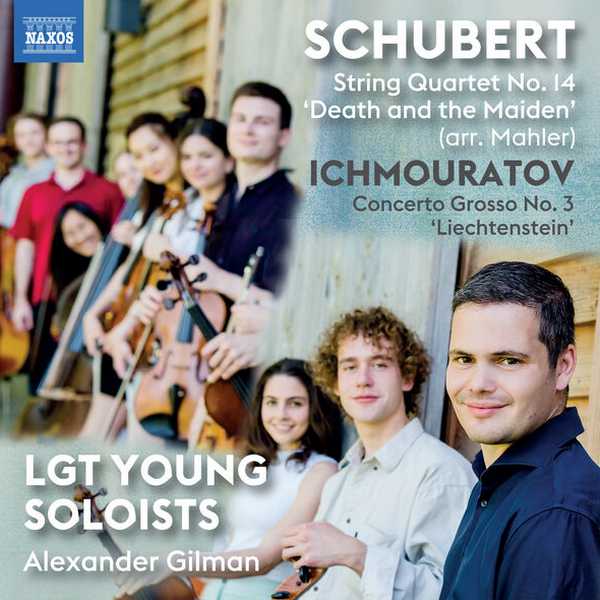

Composer: Airat Ichmouratov, Franz Peter Schubert
Orchestra: LGT Young Soloists
Conductor: Alexander Gilman
Format: FLAC (tracks)
Label: Naxos
Catalogue: 8579165
Release: 2024
Size: 1.03 GB
Recovery: +3%
Scan: yes
Schubert: String Quartet No. 14 in D Minor, D. 810 “Death and the Maiden” (Arr. for String Orchestra by Gustav Mahler)
01. I. Allegro
02. II. Andante con moto
03. III. Scherzo. Allegro molto – Trio
04. IV. Presto
Ichmouratov: Concerto Grosso No. 3, Op. 68 “Liechtenstein”
05. I. Allegro agitato
06. II. Largo
07. III. Allegro giocoso
Gustav Mahler arranged Schubert’s String Quartet No. 14 ‘Death and the Maiden’ by expanding it into a grand orchestral spectacle. It reveals his admiration for Schubert and serves to intensify the quartet’s journey through life, death and human resilience in this fusion of two great composers’ musical visions. Airat Ichmouratov’s Concerto Grosso No. 3 is subtitled ‘Liechtenstein’ and draws on the country’s breath-taking scenery and music in an expressive and virtuoso orchestral exploration. It was composed specifically for Alexander Gilman and the LGT Young Soloists, one of the most successful touring youth orchestras throughout the world.
The LGT Young Soloists are a throwback to a time when corporations in various places sported their own ensembles, performing under the aegis of LGT Private Banking in Switzerland. They range in age from 14 to 23, and under conductor Alexander Gilman, they have been attracting lots of attention for adult-level performances like the ones here. That bank is owned by Liechtenstein’s royal family, which is perhaps the reason for the inclusion here of the peppy Concerto Grosso No. 3, Op. 68 (“Liechtenstein”), by composer Airat Ichmouratov. The main attraction is Mahler’s arrangement of Schubert’s String Quartet No. 14 in D minor, D. 810 (“Death and the Maiden”). This is rarely heard because Mahler left it somewhat unfinished, giving his marked-up score to other composers and performing only the Andante movement, but it has a somewhat different flavor from Mahler’s arrangements of Beethoven’s symphonies and is well worth hearing. The graphics for this album assert that Mahler turned the quartet into a “grand orchestral spectacle,” and this isn’t quite right; it is for a small string orchestra, after all, but it has a slightly stressed, showy quality that is quite Mahlerian. The young players pick up on this mood (Mahler does tend to appeal to teenage angst), and the result is a strong, clean performance. Naxos records the music cleanly at Henry Wood Hall in London, and those curious about this unique young ensemble would do well to start here.



